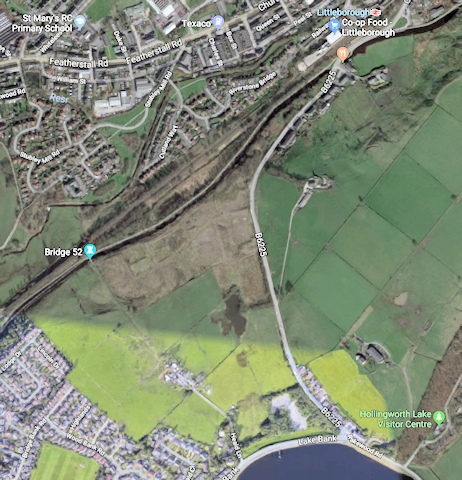Rochdale’s green fields are nature’s antidepressant, says local psychological wellbeing practitioner
Date published: 15 March 2019

Land north of Smithy Bridge near Hollingworth Lake included in the Spatial Framework
A psychological wellbeing practitioner from Smithy Bridge says the Greater Manchester Spatial Framework would be a 'contributing factor to increased mental health problems in the borough'.
Clare Stephenson, who is also a lecturer in mental health, said: “As a resident of Smithy Bridge, it is unclear to me how this planned housing development would be at all beneficial to any of the residents within the borough. This proposed development is a bad idea as it would be a contributing factor to increased mental health problems in the borough.
“However, there are many other arguments as to why building in Littleborough and Smithy Bridge is not environmentally acceptable, including: increase in traffic and pollution, the destruction of local ecology including insects and wildlife, and pressure on existing services.
“A vast array of evidence supports the link between mental health, wellbeing and green space and the local CCG and NHS are spending millions on treating mental health problems yet planning policy is making this problem worse by ignoring the evidence and depriving residents of nature’s antidepressant of green space.
“The characteristics of our environment have been shown to directly relate to our mental health. Studies have shown that green space is associated with better mental health, including less risk of depression and reduced psychological distress. As natural green environments have increasingly come under pressure from economic development, so it seems our own wellbeing has suffered consequently.
“There are many factors that contribute to the occurrence of mental health problems including psychological, biological, social and environmental factors. Mental health problems are a growing public concern. It is estimated that one in four individuals will experience a mental health issue at some point in their life.
“Incidentally, Rochdale is the 12th highest CCG for antidepressant prescribing in England.”
She continued: “The presence of green space is widely viewed as a health promoting characteristic of residential environments, with links to health and societal benefits such as recovery from mental, stress reduction, neighbourhood social cohesion, reductions in crime, violence and aggression, reduced morbidity in multiple disease categories and better self -reported health.
“Green space can have direct protective effects against health hazards posed by air pollution, extreme temperature, and noise pollution, and has also been associated with increased health promoting behaviours such as physical activity.
“Research suggests exercise in pleasant environments may have a greater effect on blood pressure, an important measure of cardiovascular health, and on measures that are relevant to mental health rather than exercise alone. Therefore, green exercise has important implications for public and environmental health.”
Ms Stephenson carried on: “Studies also show an even stronger relationship between green space and health among lower socioeconomic status groups, the elderly, and others who stay home during the day, providing some support for the notion that the size of the effect of local green space on health is related to the amount of an individual’s exposure to the local environment.
“Increasing neighbourhood access to green space could be a cost-effective strategy to improving health and reducing health disparities, as lower socioeconomic status groups have a more limited ability to travel beyond local neighbourhoods, resulting in increased dependence on local environments for healthy lifestyles and exposures.
“The evidence indicates that nature can make positive contributions to our health, help us recover from pre-existing stresses or problems, and help us to concentrate and think more clearly.
“There are many residents that will be directly impacted by the GMSF development and less green nature means reduced mental well-being, or at least, less opportunity to recover from mental stress.”
Land put forward locally under the Greater Manchester Spatial Framework includes Bamford and Norden, Castleton Sidings, Crimble Mill, land north of Smithy Bridge, Newhey Quarry, Roch Valley and Trows Farm.
The consultation for the Greater Manchester Spatial Framework, currently in its second draft, will close on Monday 18 March 2019.
Have your say:
- www.gmconsult.org/communications-and-engagement-team/gmsf/
- Send postal objections to: Planning Team Consultation, GMCA, Church gate House, 56 Oxford St, Manchester M1 6EU
- Email: planningandhousing@greatermanchester-ca.gov.uk
Do you have a story for us?
Let us know by emailing news@rochdaleonline.co.uk
All contact will be treated in confidence.
Most Viewed News Stories
- 1Royton haulage firm fined after Rochdale dad went to work and didn’t come home
- 2Unique colour and sound experience comes to Rochdale in May
- 3Ogden family announces intention to invest £2m in Rochdale AFC
- 4Man convicted after police car filmed driving dangerously in Kirkholt
- 5Rochdale church to host Camerados public living room
To contact the Rochdale Online news desk, email news@rochdaleonline.co.uk or visit our news submission page.
To get the latest news on your desktop or mobile, follow Rochdale Online on Twitter and Facebook.


